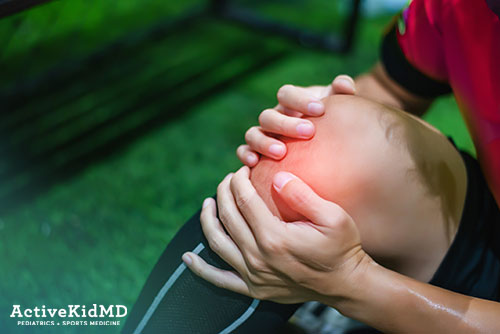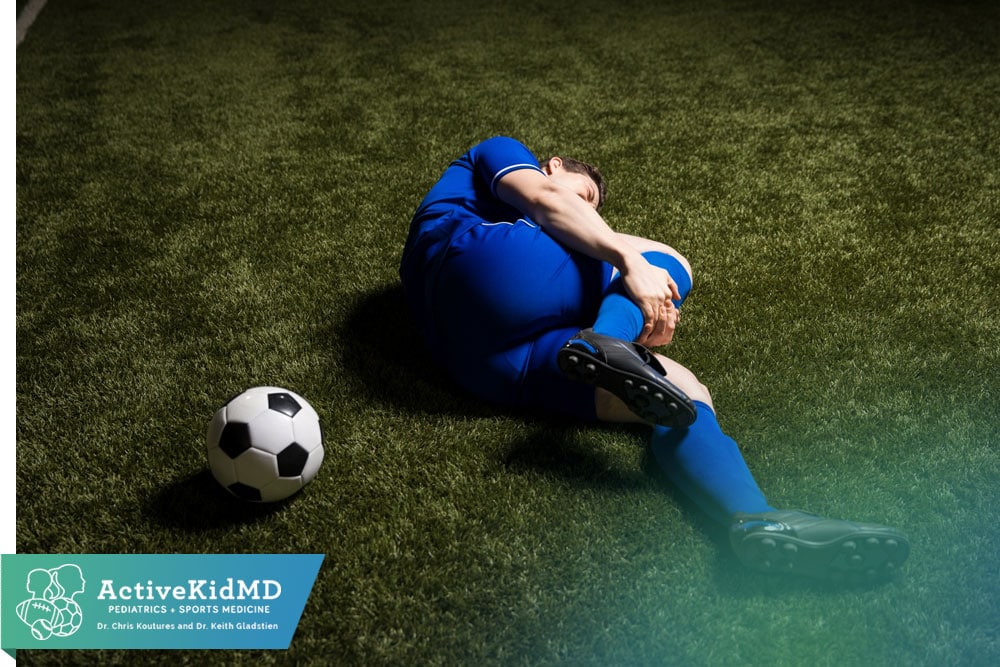It should be no surprise that the majority of injuries seen in soccer players involve the lower body.
Unless you are a goalkeeper, the main movements include using the legs to kick, jump, run and do slide tackles.
Knees are central to all this movement, and as players enter their teenage years, knees overcome ankles as the most common joint injury in soccer players.
Read on for expert sports medicine tips to protect knees to keep yourself or your favorite soccer player(s) on the field.
RELATED TOPIC: I’m not trying to discount the risk of head injuries in soccer or the unique injury risks of goalkeepers. Click here to learn more about soccer concussions and how to protect goalkeepers.
ACL (Anterior Cruciate Ligament, aka “All too Common Ligament” Injuries)
Let’s start with the big one: the serious type of knee injury that can keep players off the field for up to a year, or even longer. The Anterior Cruciate Ligament (ACL) connects the thigh bone to the shin bone in the center of the knee and provides stability with landing from jumps or changing direction.
ACL injuries can occur from direct contact to the knee, but in soccer, and especially with adolescent female players, non-contact awkward single-leg cuts, turns or landings are often the culprit.
Defensive tackling (often accompanied by a sidestep movement) to reach out and separate an opponent from the ball, as well as cutting to track an opponent, have been identified as other potential risk factors for ACL injury.
RELATED TOPIC: Soccer ACL Injuries: Two Common Movements often Lead to Tears
Not only are ACL tears immediately painful, but they are also selfish and can cause problems years after the original injury.
Tears to other ligaments or of the menisci (shock-absorbing pads on the inside and outside of the knee) often come with ACL tears. Most players who tear their ACL (and other structures) need surgical repair and a prolonged recovery period.
Even after that extended rehabilitation, going back to soccer increases the risk (by 25-33%) of another ACL tear to either the injured or non-injured knee. Whether or not a player returns, having an ACL tear carries a close to 50% risk of early arthritis (knee joint breakdown) within 10-20 years of the injury. That’s a lot of relatively young 30 somethings maybe needing knee joint replacement surgery.
With all this doom and gloom, there is a glimmer of good news on the ACL front. There are practical and proven ways to reduce non-contact ACL injuries.
If you have 10-15 minutes, you have the time to complete a proper evidence-based ACL Injury Prevention Program Yes, a mere 10-15 minute investment 3 times a week can help reduce a major injury, major rehab period and major risk of arthritis. Then we’ll throw the added bonus of increasing strength and efficiency of running and jumping.
CLICK HERE FOR A DESCRIPTION OF ACL INJURY REDUCTION/KNEE AND LOWER LEG STRENGTHENING PROGRAMS
Kneecap (Patella) Instability

The most dramatic type of disruption is called a patellar dislocation, where the kneecap comes completely out of its usual position and can be found on the outside of the thigh bone. Sometimes the kneecap can be repositioned on the field with a particular relocation movement, while other cases require an emergency room and special medication to relax the knee (and patient).
The kneecap can also partially come out of joint. This is known as a patellar subluxation. This abnormal motion toward the outside of the knee joint can occur on a recurrent basis and lead to lasting episodes of pain and limited bending/straightening of the knee.
The odds of increased kneecap motion (aka patellar laxity) can be reduced by learning the same landing and cutting skills taught in those ACL Injury reduction programs.
When seeing players with kneecap instability (and I definitely recommend specialist sports medicine evaluation for any type of patellar laxity problems), I tend to look at things like increased motion in other joints, abnormal muscle function in the front and outside of the knee, and single-leg squat technique.
Treatments can include strengthening exercises for hip, upper leg and knee regions along with stretching of muscle groups. Knee sleeve braces with padding/support for the outside of the kneecap can help. I’ve learned that some soccer players find them too bulky for quick movements while others want to wear one on each knee (so opponents have to guess about the injured knee).
Anterior Knee Pain
Yes, patellar instability is indeed one cause of pain in the front of the knee, but there are several other flavors that affect soccer players.
Younger players who haven’t reached full adult height may commonly report pain at growth regions (aka the apophysis) of the tibial tubercle and lower part of the patella. Osgood-Schlatter is the medical name for irritation of the tibial tubercle, while pain at the lower patella is known as Syndesmotic-Larson-Johanson syndrome.
The diagnosis is pretty straightforward. The athlete can use a fingertip to pinpoint the location of pain with local swelling, typically with a gradual onset. A prominent bump may be seen at the tibial tubercle on the shin bone just below the knee joint. That bump usually goes away after growth is finished, but not always.
Once a player finishes growing, we tend to see more issues with either the patellar tendon (connects the four quadricep muscles in the front of the thigh through the kneecap to attach at the shin bone) or more general patellofemoral pain between kneecap and thigh bone.
Relative weakness of the muscles behind the hips and upper thigh can contribute to excessive forces in the front of the knee. Once again, the same ACL injury prevention exercises previously discussed (and linked above) can also help reduce other forms of anterior knee pain.
So if you’ve experienced a knee injury, give us a call so we can get you on the road to recovery and back on the field.



